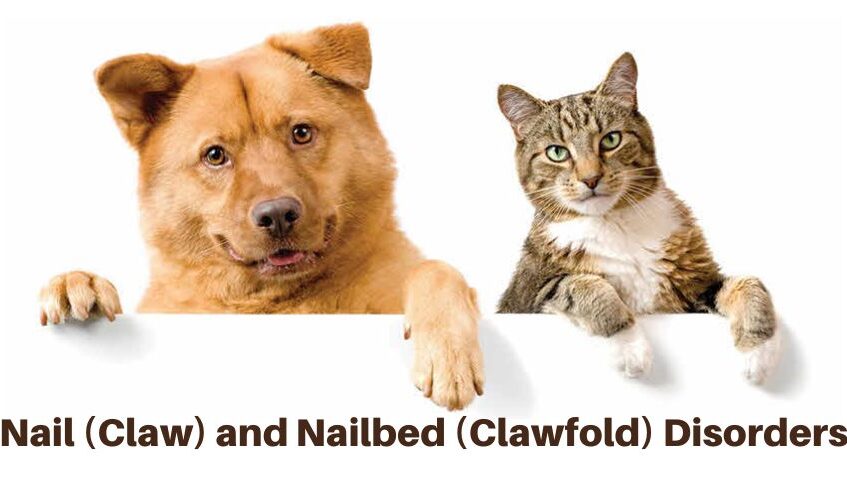Nail (Claw) and Nailbed (Clawfold) Disorders
Dogs and cats with claw diseases are presented infrequently in small animal practice. However, inflammation and/or infection of claws frequently are very painful due to the anatomical features of this structure (the dermis and noncornified epidermis are situated between the stratum corneum comprising the hard claw horn and the bony third phalanx and no subcutis is present). Thus, claw disease may be a cause of great distress to patient and owner alike.
Nails and ungual folds—subject to trauma, infection, vascular insufficiency, immune-mediated disease, neoplasia, defects in keratinization, and congenital abnormalities.
Ungual fold—crescent-shaped tissue that surrounds the proximal nail
Coronary band and dorsal ridge—produces most of the nail
Paronychia—inflammation of soft tissue around the nail
Onychomycosis—fungal infection of the nail
Onychorrhexis—brittle nails that tend to split or break
Onychomadesis—sloughing of the nail
Nail dystrophy—deformity caused by abnormal growth; often a sequela of a disorder
Onychomalacia—softening of the nails
SIGNALMENT
- Dog and cat
- Mean age range—SLO 3–8 years
- No predominant sex reported
SIGNS
- Licking at the feet and/or ungual folds
- Lameness
- Pain
- Swelling, erythema, and exudate of ungual fold
- Deformity or sloughing of nail
- Discoloration of the nail
- Hemorrhage from the nail or at loss of a nail
- Previous description of being “tender-footed”
CAUSES
Paronychia
- Infection—bacteria, dermatophyte, yeast (Candida, Malassezia), leishmaniasis
- Demodicosis
- Immune-mediated—pemphigus, bullous pemphigoid, SLE, drug eruption, SLO
- Neoplasia—subungual squamous cell carcinoma, melanoma, eccrine carcinoma, osteosarcoma, subungual keratoacanthoma, inverted squamous papilloma
- Arteriovenous fistula
Onychomycosis
- Dogs—Trichophyton mentagrophytes—usually generalized
- Cats—Microsporum canis
Onychorrhexis
- Idiopathic—especially in dachshunds; multiple nails
- Trauma
- Infection—dermatophytosis, leishmaniasis
Onychomadesis
- Trauma
- Infection
- Immune-mediated—pemphigus, bullous pemphigoid, SLE, drug eruption, SLO
- Vascular insufficiency—vasculitis, cold agglutinin disease
- Neoplasia—see above
- Idiopathic
Nail Dystrophy
- Acromegaly
- Feline hyperthyroidism
- Zinc-responsive dermatosis
- Congenital malformations
DIAGNOSIS
DIFFERENTIAL DIAGNOSIS
- Trauma or neoplasia often affects a single nail.
- Involvement of multiple nails suggests a systemic disease.
- Immune-mediated diseases (except SLO) usually have other skin lesions in addition to nail or ungual fold lesions.
CBC/BIOCHEMISTRY/URINALYSIS
May show evidence of SLE, diabetes mellitus, hyperthyroidism, or other systemic illness.
OTHER LABORATORY TESTS
- FeLV
- Serum thyroxine
- ANA titer
- IMAGING
- Radiographs—osteomyelitis of third phalanx, neoplastic change
OTHER DIAGNOSTIC PROCEDURES
- Biopsy—often involves a third phalanx amputation; inclusion of the coronary band required for diagnosis of most diseases
- Cytology of exudate from the nail and/or fold
- Skin scraping
- Bacterial and fungal culture
TREATMENT
PARONYCHIA
- Surgical removal of nail plate (shell)
- Antimicrobial soaks
- Identify underlying condition and treat specifically.
ONYCHOMYCOSIS
- Antifungal soaks—chlorhexidine, povidone iodine, lime sulfur
- Surgical removal of nail plate—may improve response to systemic medication
- Amputation of third phalanx
ONYCHORRHEXIS
- Repair with fingernail glue (type used to attach false nails in humans).
- Remove splintered pieces and maintain with rotary sander (Dremel).
- Treat underlying cause.
- Amputate third phalanx, last resort.
ONYCHOMADESIS
- Antimicrobial soaks
- Treat underlying cause
NEOPLASIA
- Determined by biologic behavior of specific tumor
- Surgical excision
- Amputation of digit or leg
- Chemotherapy and/or radiation therapy
NAIL DYSTROPHY
- Treat underlying cause
MEDICATIONS
DRUG(S) OF CHOICE
- Bacterial paronychia—systemic antibiotics based on culture and sensitivity.
- Yeast paronychia—Candida or Malassezia paronychia—ketoconazole (5–10 mg/kg PO q12–24h); topical nystatin or miconazole.
- Onychomycosis—griseofulvin (50–150 mg/kg PO/day) or ketoconazole (5–l0 mg/kg PO q12h) for 6–12 months until negative cultures; itraconazole (10 mg/kg PO q24h) for 3 weeks and then pulse therapy until resolved.
- Onychomadesis—determined by cause; immunomodulation therapy for immune-mediated diseases; medications include cyclosporine, doxycycline with niacinamide, pentoxifylline, vitamin E, essential fatty acid supplementations, and chemotherapeutic agents (e.g., azathioprine, chlorambucil).
CONTRAINDICATIONS
Griseofulvin—do not use in pregnant animals.
PRECAUTIONS
- Griseofulvin—may cause bone marrow suppression, anorexia, vomiting, and diarrhea; absorption enhanced if given with a high-fat meal.
- Ketoconazole—may cause anorexia, gastric irritation, hepatic toxicity, and lightening of the hair coat.
FOLLOW-UP
EXPECTED COURSE AND PROGNOSIS
- Bacterial or yeast paronychia and onychomycosis—treatment may be prolonged and response may be influenced by underlying factors.
- Onychorrhexis—may require amputation of the third phalanx for resolution.
- Onychomadesis—prognosis determined by underlying cause; immune-mediated diseases and vascular problems carry a more guarded prognosis than do trauma or infectious causes.
- Neoplasia—excised by amputation of the digit; malignant tumors metastasize by the time of diagnosis.
Visit your veterinarian as early recognition, diagnosis, and treatment are essential.
You may also visit – https://www.facebook.com/angkopparasahayop




